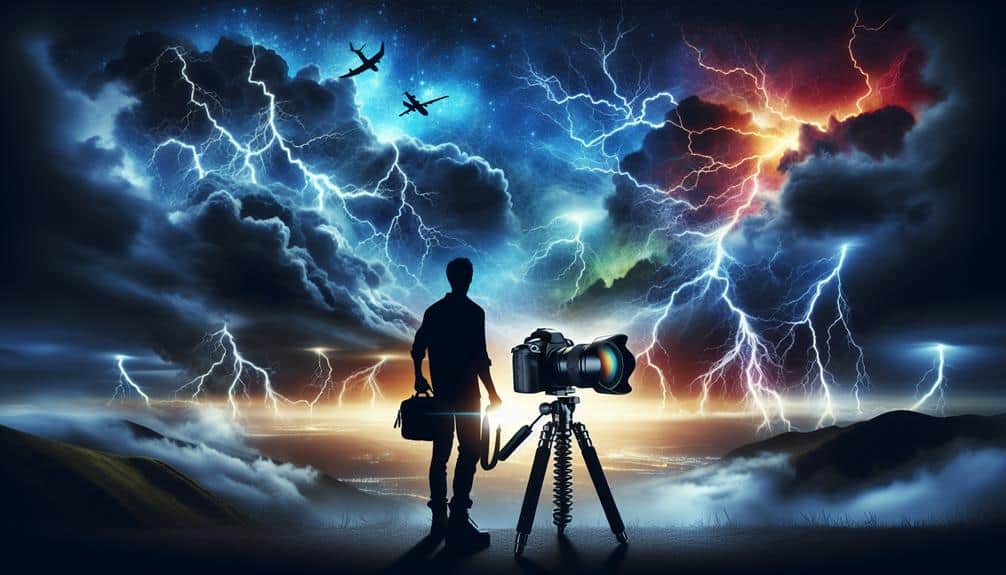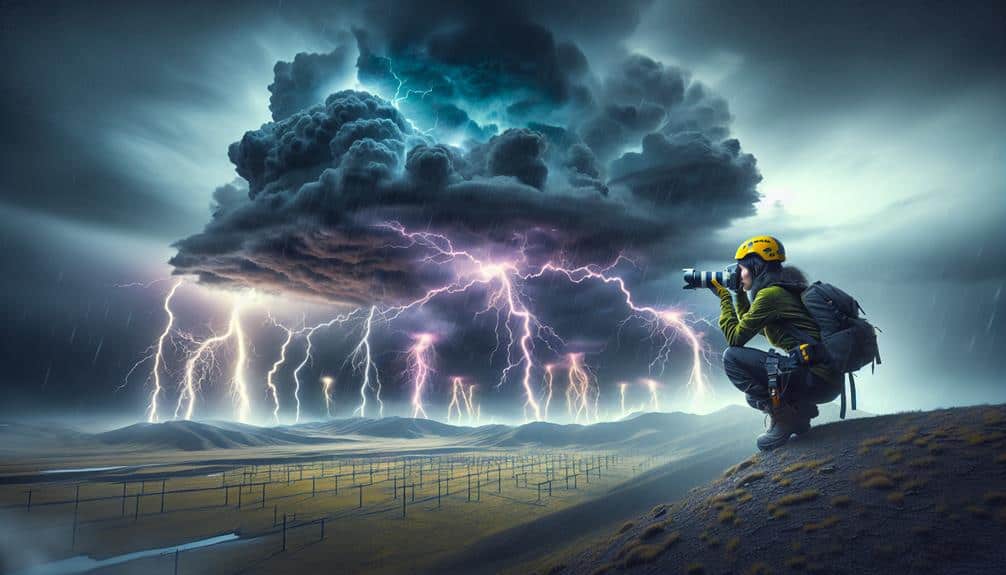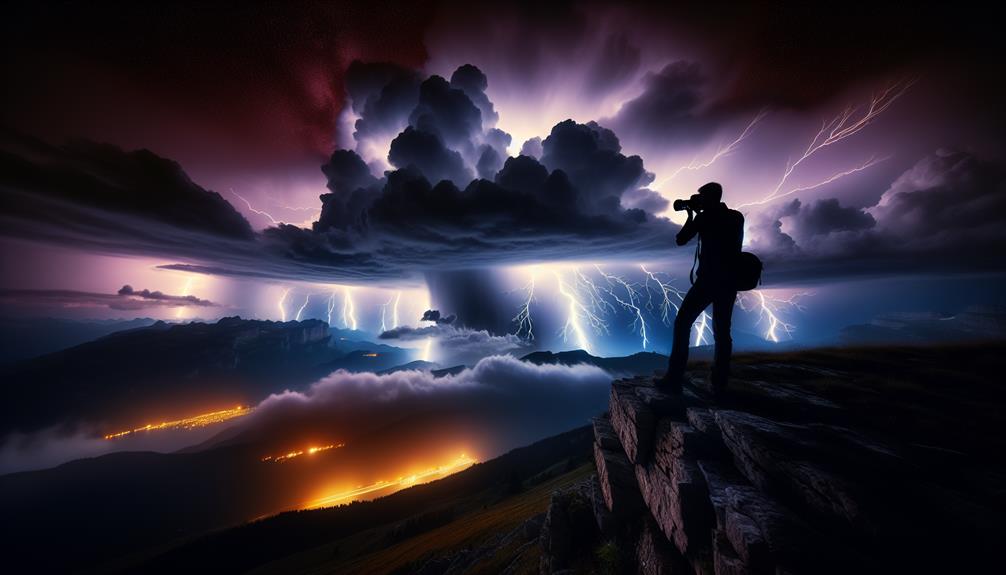We capture multiple lightning strikes using three primary techniques that blend technical skill and visual artistry. First, we use long exposure photography to extend the shutter speed, gathering more light for striking night sky shots. Second, lightning triggers help us catch the precise moments of lightning by automatically activating the shutter, letting us focus on the perfect frame. Finally, we stack multiple shots during storms, layering them in post-processing to create composite images that showcase the storm's full drama and intensity. Each method brings out the chaotic beauty of nature's lightshow, offering different perspectives on mastering these techniques.
Key Points
- Use long exposure photography to capture multiple lightning strikes in one frame by extending the shutter speed.
- Employ lightning triggers to automatically activate the camera shutter at the precise moment of a lightning strike.
- Fine-tune the lightning trigger sensitivity for accurate responsiveness to different storm patterns and conditions.
- Stack multiple long-exposure shots in post-processing to create a composite image showcasing the full drama of the lightning storm.
Long Exposure Photography
By extending the shutter speed on our cameras, we can capture the dramatic sequence of multiple lightning strikes in a single frame. This technique, known as long exposure photography, allows us to immortalize the electrifying dance of light across the night sky.
When we set up our cameras for a long exposure, we open the shutter for several seconds, or even minutes, allowing the sensor to gather more light. This approach is essential in night photography, where ambient light is scarce.
To achieve this, we need to mount our cameras on sturdy tripods to prevent any movement during the exposure. We then adjust our settings to a low ISO and a small aperture to reduce noise and guarantee a sharp image. As the shutter remains open, it captures light trails from moving objects, such as stars, airplanes, and of course, lightning bolts.
Timing is vital. We must anticipate when and where the next strike will occur, often relying on our intuition and experience. The result? A single, breathtaking image that tells a story of nature's raw power and our ability to capture it.
Let's embrace the freedom to explore and document the night sky in all its glory.
Use of Lightning Triggers
Lightning triggers offer a precise and efficient way to capture elusive lightning strikes by automatically activating the camera's shutter at the exact moment a strike occurs. This technology frees us from the constraints of manual shutter control and allows us to focus on framing and composition. By fine-tuning the trigger sensitivity, we can adjust how responsive the device is to various lightning patterns, guaranteeing we don't miss out on any electrifying moments.
When we set up our gear in the field, the lightning trigger becomes an essential part of our toolkit. It senses the sudden change in light intensity that occurs during a lightning strike and instantly signals the camera to take a shot. This split-second reaction time is vital for capturing the intricate details and dramatic impact of lightning, which often lasts mere milliseconds.
Adjusting trigger sensitivity allows us to refine our approach based on the specific storm conditions. For instance, in a storm with frequent, less intense strikes, we can decrease the sensitivity to avoid capturing irrelevant shots. Conversely, in a storm with sporadic, powerful bolts, increasing the sensitivity guarantees we capture every breathtaking moment.
Ultimately, using lightning triggers enables us to document the awe-inspiring beauty of lightning with precision and confidence.
Stacking Multiple Shots
When we stack multiple shots, we create a composite image that showcases the full drama and complexity of a lightning storm. This technique allows us to capture multiple lightning strikes in a single frame, highlighting the chaotic beauty of the weather patterns. To master this, we first need to take a series of long-exposure shots during a storm, ensuring our camera settings are optimized to avoid overexposure.
In post-processing, image editing software like Adobe Photoshop or Lightroom becomes our best ally. We import our shots and use layer masks to carefully blend the images. This meticulous process demands attention to detail; each lightning strike must be aligned perfectly to maintain the natural look of the storm.
Layer by layer, we build a narrative that a single shot just can't tell. The final composite reveals the storm's full intensity, offering a visual story that captures both the fleeting chaos and the majestic rhythm of nature.
Frequently Asked Questions
What Safety Precautions Should Be Taken When Photographing Lightning?
When doing lightning photography, we should prioritize safety precautions by staying indoors or in a car. For equipment protection, we must use a tripod and remote shutter, while avoiding high ground and open fields to stay safe.
How Do Weather Apps Help in Predicting Lightning Activity?
Imagine the sky's electric symphony at your fingertips. With weather apps, we harness cutting-edge technology to access real-time weather data. These apps enhance lightning prediction accuracy, giving us freedom to capture nature's fury safely and precisely.
What Camera Settings Are Ideal for Capturing Lightning During Daylight?
For capturing lightning during daylight, we need to use low ISO, small aperture, and a neutral density filter. Adjusting exposure settings and experimenting with camera angles will help us achieve stunning shots, embracing our creative freedom.
How Can I Protect My Camera Equipment in Stormy Conditions?
We've got to focus on equipment protection in stormy conditions. Use waterproof gear and camera covers to shield our gear. Every detail matters when capturing that perfect shot, and we can't afford to let the weather ruin it.
What Lens Types Are Best Suited for Lightning Photography?
For lens selection, wide-angle lenses excel in capturing the vast sky during stormy lighting conditions. Use manual focusing techniques for sharp shots and consider composition tips like including foreground elements to enhance the dramatic storytelling of the scene.


